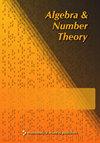𝒳0(N)上的算术Siegel-Weil公式
IF 1
1区 数学
Q2 MATHEMATICS
引用次数: 0
摘要
对于任意阶N,我们在模曲线𝒳0(N)上建立了算术Siegel-Weil公式,即将𝒳0(N)上特殊循环的算术度与2类爱森斯坦级数的傅里叶系数的导数联系起来。我们通过与𝒳0(N)相关的Rapoport-Zink空间上的局部算术交点数与二次型的局部表示密度的导数之间的精确恒等式证明了这个公式。当N为奇数且无平方时,这对Sankaran、Shi和Yang的主要工作结果给出了不同的证明。这个局部恒等式通过与一个更高维度的超特殊层次的恒等式相关联来证明。本文章由计算机程序翻译,如有差异,请以英文原文为准。
Arithmetic Siegel–Weil formula on 𝒳0(N)
We establish the arithmetic Siegel–Weil formula on the modular curve for arbitrary level , i.e., we relate the arithmetic degrees of special cycles on to the derivatives of Fourier coefficients of a genus-2 Eisenstein series. We prove this formula by a precise identity between the local arithmetic intersection numbers on the Rapoport–Zink space associated to and the derivatives of local representation densities of quadratic forms. When is odd and square-free, this gives a different proof of the main results in work of Sankaran, Shi and Yang. This local identity is proved by relating it to an identity in one dimension higher, but at hyperspecial level.
求助全文
通过发布文献求助,成功后即可免费获取论文全文。
去求助
来源期刊

Algebra & Number Theory
MATHEMATICS-
CiteScore
1.80
自引率
7.70%
发文量
52
审稿时长
6-12 weeks
期刊介绍:
ANT’s inclusive definition of algebra and number theory allows it to print research covering a wide range of subtopics, including algebraic and arithmetic geometry. ANT publishes high-quality articles of interest to a broad readership, at a level surpassing all but the top four or five mathematics journals. It exists in both print and electronic forms.
The policies of ANT are set by the editorial board — a group of working mathematicians — rather than by a profit-oriented company, so they will remain friendly to mathematicians'' interests. In particular, they will promote broad dissemination, easy electronic access, and permissive use of content to the greatest extent compatible with survival of the journal. All electronic content becomes free and open access 5 years after publication.
 求助内容:
求助内容: 应助结果提醒方式:
应助结果提醒方式:


